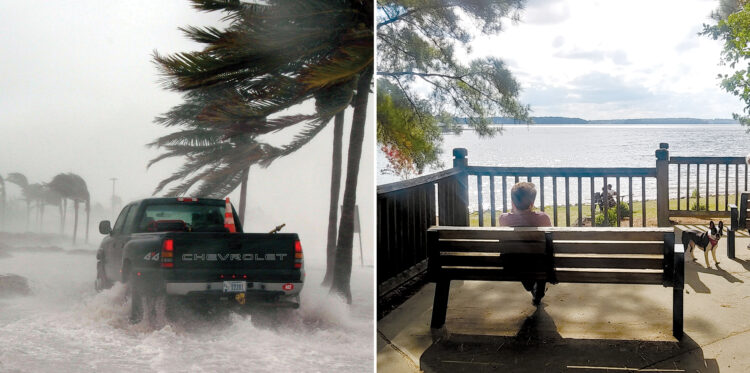
Florida vs. Lake Norman
March 15. By Dave Yochum. The United States is expected to experience as much sea level rise in the next 30 years as it has in the past 100 years, meaning coastal flooding in the Carolinas will be a more frequent event.
The Sea Level Rise Technical Report from the National Oceanic and Atmospheric Administration projects sea levels will rise an additional 10-12 inches by 2050.
“Major” flooding is expected to occur five times as often in 2050 as it does today.
Could rising sea levels make a home on or near Lake Norman more desirable than a swank abode on the Intracoastal Waterway?
Aye, matey.

Jennings
“Rising sea levels are an increasing concern for coastal investors, and a problem Lake Norman waterfront property owners don’t have to fear. Year-round amenities, our quality of life, and our proximity to Charlotte are also factors for newcomers weighing their options between the Inland Sea and the coast,” said Abigail Jennings, co-owner of Lake Norman Realty.
Economic impact
Indeed, a study by the National Bureau of Economic Research said property sales in Florida census tracts that were most exposed to sea level increase declined after 2013 relative to sales in less-exposed areas. Prices tended to fall later; by 2020, prices in these markets were 5 to 10 percent below trend.
Higher sea levels can affect everything from coastal fisheries to real estate.
In the United States alone, $300 billion in “shoreline armoring” costs are forecast by 2100, according to a 2021 article in the Proceedings of the National Academy of Sciences.
Sea level rise leads to increased coastal flooding, even in the absence of heavy rain or storms, perhaps making Lake Norman—aka The Inland Sea—more appealing long-term than some of the most popular coastal towns from the Jersey Shore to Savannah.
‘Code red’
The new data on sea level rise is the latest reconfirmation that our climate crisis is “blinking code red,” said Gina McCarthy, National Climate Advisor.
She said redoubling efforts to cut the greenhouse gases will help our coastal communities.
Inland lakes will have fewer concerns about flooding since we do not have rising sea levels, but dams like Cowans Ford that can spill excess water.
“Since our lake shores will not be negatively impacted like our coastal waterfront properties, Lake Norman/Wylie/Mountain Island Lake will be even more appealing to those who are seeking waterfront living,” said Pam Boileau, an Ivester Jackson senior broker who specializes in high-end properties.
Real life example
Scott Yearwood moved to Lake Norman with his wife from the coast due, in part, to coastal flooding and storms, as well as prospects for more—and worse—to come.
In 2018 they moved to Seabrook Island in Charleston County South Carolina.
During the first few months of living there, it was necessary—or at least prudent—to evacuate twice in less than 90 days due to named storms threatening the island.
The stress around evacuating up I-26 and the fear of losing personal effects was enough to say enough was enough.
“No question those factors were a major part of why we decided to get out and recoup our real estate investment while we could,” Yearwood said.
Two feet by 2100
At least two feet of sea level rise is likely by 2100.
By 2050, moderate flooding — which is typically disruptive and damaging by today’s weather, sea level and infrastructure standards — is expected to occur more than 10 times as often as it does today, according to Nicole LeBoeuf, NOAA National Ocean Service Director.
It means a change from a single event every two to five years years to multiple events each year, depending on location.
A report from McKinsey & Co. says average annual losses for residential real estate due to storm surge damage in Florida are $2 billion and could increase to about $2.5 billion to $3 billion by 2030 and up to $4.5 billion by 2050.
Ripple effect
It’s all especially interesting in Florida which has no state income tax—it has a heavy reliance on property taxes. Lower real estate prices could in turn impact state revenue.

Boileau
Of course the seawall business could boom, but generally speaking fighting the ocean is a Titanic battle.
Based on historical experience, the experts at McKinsey “conservatively estimate” a total devaluation in Florida of about $10 billion to $30 billion of affected homes by 2030, rising to $30 billion to $80 billion by 2050.”
That’s the equivalent of a 5 percent to 15 percent impact in 2030 and 15 percent to 35 percent in 2050, all else being equal.
“The Lake Norman area has experienced tremendous growth in the last few years and now that this new data is indicating the coastal areas may have significant flooding issues, I foresee the level of interest in living here and investing in our area to be far greater,” Boileau said.
According to the National Oceanic & Atmospheric Administration studies, local sea level changes may be more or less than the global average, based on:
• Changes in land elevation, such as subsidence resulting from sediment compaction or extraction of ground water and fossil fuels
• As ice sheets in Greenland and Antarctica lose their mass, their gravitational pull on the ocean weakens. Sea level nearby drops and rises farther away
• Changes in ocean circulation. Locally, changes in these currents can cause more water to build up next to the land, raising sea level.
Source: NOAA 2022 Sea Level Rise Technical Report

There are requests to find 2nd home/investment properties weekly at the Coastal Carolinas from folks living in & around Mecklenburg County- apparently no one interviewed those folks who can pay the same amount for Oceanfront as they can for a waterfront view on a man-made lake that frequently has sewage spills…that alone is worth extra flood insurance at the Coast, in my opinion…
Posted by Ralph Malph | March 15, 2022, 6:57 pm